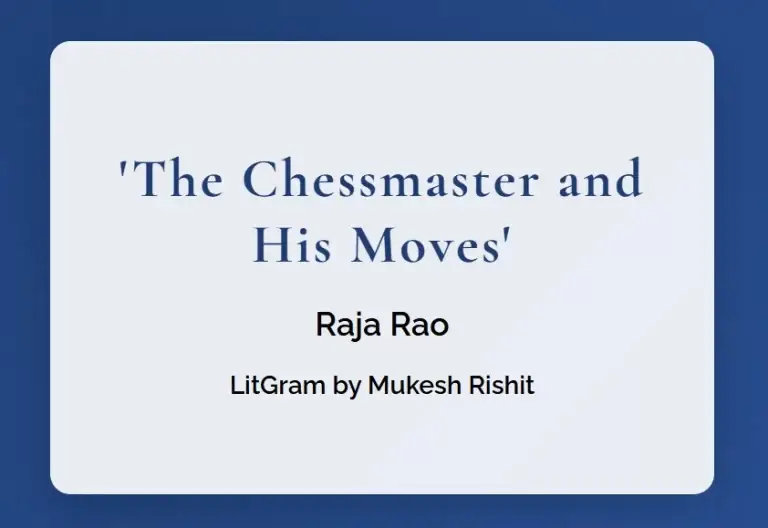Introduction: An Intricate Canvas of Philosophy, Love, and Identity
Raja Rao, a master of weaving philosophy and literature together, has given the world a deeply meditative and contemplative novel with The Chessmaster and His Moves. This book delves into themes of metaphysics, identity, spirituality, and love, all intricately interwoven with Rao’s signature use of allegory and symbolism. Considered one of Rao’s most complex works, this novel amplifies the richness of Indo-European philosophical discourse while exploring the inner conflicts of humans navigating their destiny.
Table of Contents
But what makes such a text so compelling? At its heart, it raises profound questions about human relationships, particularly between men and women, mapped onto a metaphorical chessboard, where the titular “Chessmaster” governs life’s strategies and complexities. By the end of this article, you’ll gain insight into the novel’s summary, characters, themes, and its deeper metaphorical implications.
1. Who is Raja Rao? A Brief Introduction
Before diving into the novel, it’s essential to recognize the significance of its author. Raja Rao (1908–2006) is a towering figure in Indian English literature. His works often merge Indian metaphysical traditions with Western literary techniques, creating narratives rich in philosophical depth and cultural interplay. Rao’s other celebrated works include Kanthapura, centering on India’s rural life and independence movement, and The Serpent and the Rope, a semi-autobiographical philosophical exploration. His writing isn’t simply literature—it’s a spiritual and intellectual experience.
2. Synopsis of The Chessmaster and His Moves
Published in 1988, The Chessmaster and His Moves follows Sivaswamy (often referred to as Siva), a man of Indian origin living in Europe. Through the novel, we see his travels across France, Switzerland, and other parts of the continent, often caught in the currents of love, longing, and existential search.
At the heart of the novel is Siva’s romance with Alice, a European woman, which is as much an exploration of love as it is a metaphorical chess game between two consciousnesses. As the title suggests, Siva often strategizes and contemplates relationships and life events, much like a chessmaster observing and playing on a larger board. Yet, despite his intellect and spiritual awareness, he struggles between his personal desires and duty to the larger cosmic order.
Partly narrative and partly philosophical, the text weaves between episodes of dialogue, internal reflection, and references to Indian philosophy, especially Advaita Vedanta. The book’s fragmented structure can be challenging, but it underscores the nonlinear and complex nature of life itself.
3. Key Characters in the Novel
- Sivaswamy (“Siva”) – The protagonist and philosophical core of the novel. An Indian expatriate navigating questions of love, duty, and identity in a foreign land.
- Alice – A European woman who becomes both Siva’s lover and his intellectual sparring partner. Their relationship embodies the clash and connection of Eastern and Western sensibilities.
- The Chessmaster – The symbolic figure who oversees life’s game and unmasks deeper truths about human existence. Whether viewed as God, fate, or one’s higher philosophical self, this figure represents ultimate wisdom.
Beyond these main characters, the novel is populated with other figures Siva encounters, each contributing to his evolving reflections.
4. Breaking Down the Title: What is a Chessmaster?
In literal terms, a chessmaster is a highly skilled player of chess, a game requiring foresight, strategy, and patience. Yet, in the context of the novel, the term takes on a deeper existential meaning. Life itself is portrayed as a chessboard, where events unfold under the guidance of a Chessmaster—a metaphor for divine intelligence or universal order.
Siva, often introspective, sees his actions and decisions as moves carefully weighed and sometimes dictated by forces greater than himself. The novel asks: Are we merely pawns in this cosmic game, or do we share in the chessmaster’s wisdom?
5. Themes Explored in the Novel
i. Love as an Existential Journey
The relationship between Siva and Alice is not a simple romantic affair but rather a tapestry of cultural, philosophical, and emotional tensions.
ii. East vs. West
The dynamic between Indian and European worldviews reflects larger questions of identity, belonging, and cultural reconciliation.
iii. Metaphysical Reflections on Life
Much of the novel is devoted to inner monologues and reflections on existence, rooted in Vedantic philosophy.
6. A Tale of East Meets West
One of the novel’s central conflicts arises from the clash between Eastern spirituality and Western materialism. Siva, shaped by Indian metaphysical traditions, finds himself grappling with an alien landscape, both physically and emotionally. Alice embodies this collision, with her Western perspective often providing contrast to Siva’s Eastern ideals.
7. The Role of Philosophy in the Narrative
Rao’s love for philosophy seeps into every page of this novel, much as it does in The Serpent and the Rope. Concepts like non-duality (Advaita) underpin the narrative, challenging the reader to transcend conventional notions of time, space, and love.
8. Symbolism Behind the Chessboard Game
The chessboard, often referenced directly and indirectly in the novel, serves as a masterful metaphor for the game of life. Each move, calculated or impulsive, reflects human decisions, struggles, and their larger consequences.
9. The Dynamics of Love and Relationships
The love between Siva and Alice is not an easy or idealized romance. Instead, it is fraught with misunderstandings, philosophical musings, and differences in perception. Yet it becomes the central thread of the narrative, tying together its various metaphysical explorations.
10. A Look at the Writing Style
Rao’s prose is unique—rich, dense, and poetic, often incorporating long contemplative sections. While some readers find this challenging, it’s impossible to deny the grandeur and ambition of his literary voice.
11. Spiritual Undertones of the Work
Almost every scene drips with spiritual connotations, often connecting human actions to larger cosmic principles. The novel’s meditative quality invites readers to experience it not just as a story but as a journey of self-discovery.
12. Reception and Legacy of The Chessmaster and His Moves
Upon its publication, The Chessmaster and His Moves received mixed reviews, largely due to its dense and unconventional style. It remains underappreciated compared to Rao’s earlier works, yet scholars recognize it as a masterpiece of philosophical literature.
13. Significance of the Novel in Raja Rao’s Oeuvre
The Chessmaster and His Moves can be seen as the culmination of Rao’s literary career, synthesizing his lifelong interests in love, philosophy, and spiritual inquiry.
14. Comparisons with Rao’s Other Works
A direct comparison can be drawn with The Serpent and the Rope, which also deals with love and philosophy but in a more structured narrative format. The fragmented style of The Chessmaster and His Moves sets it apart, though the themes are deeply interconnected.
15. Final Thoughts and Why You Should Read It
To read The Chessmaster and His Moves is to immerse yourself in a philosophical exploration of life, love, and identity. Despite its challenges, the novel rewards patient readers with profound insights and a deeper understanding of human connections.
16. FAQs About The Chessmaster and His Moves
Q1. What is The Chessmaster and His Moves about?
It’s a philosophical novel exploring themes of love, metaphysics, and identity through the experiences of Siva, an Indian expatriate in Europe.
Q2. Why is the Chessmaster symbolic in the novel?
The Chessmaster represents a metaphysical force or higher intelligence that governs and influences human life, much like a strategizing chess player.
Q3. What themes are central to Raja Rao’s novel?
Themes of cross-cultural relationships, spiritual inquiry, love, and the clash of Eastern and Western philosophies dominate the novel.
Q4. Why is the novel considered challenging?
Its fragmented narrative structure, philosophical density, and reliance on symbolic imagery make it a complex but rewarding read.
Q5. How does The Chessmaster and His Moves compare to Rao’s other works?
It continues the philosophical and spiritual themes seen in The Serpent and the Rope, though with a more experimental and fragmented structure.
Raja Rao’s The Chessmaster and His Moves challenges readers to step beyond conventional storytelling and explore deeper truths. Are you ready to make your next move?


